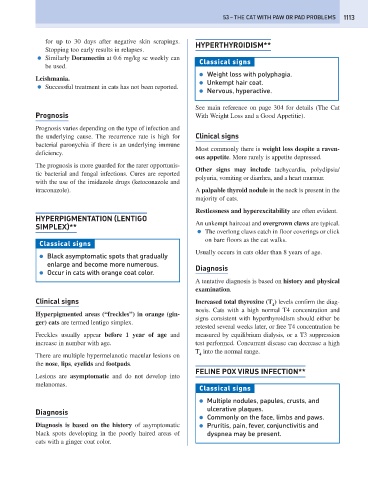Page 1121 - Problem-Based Feline Medicine
P. 1121
53 – THE CAT WITH PAW OR PAD PROBLEMS 1113
for up to 30 days after negative skin scrapings.
HYPERTHYROIDISM**
Stopping too early results in relapses.
● Similarly Doramectin at 0.6 mg/kg sc weekly can
Classical signs
be used.
● Weight loss with polyphagia.
Leishmania.
● Unkempt hair coat.
● Successful treatment in cats has not been reported.
● Nervous, hyperactive.
See main reference on page 304 for details (The Cat
Prognosis With Weight Loss and a Good Appetitie).
Prognosis varies depending on the type of infection and
the underlying cause. The recurrence rate is high for Clinical signs
bacterial paronychia if there is an underlying immune
Most commonly there is weight loss despite a raven-
deficiency.
ous appetite. More rarely is appetite depressed.
The prognosis is more guarded for the rarer opportunis-
Other signs may include tachycardia, polydipsia/
tic bacterial and fungal infections. Cures are reported
polyuria, vomiting or diarrhea, and a heart murmur.
with the use of the imidazole drugs (ketoconazole and
itraconazole). A palpable thyroid nodule in the neck is present in the
majority of cats.
Restlessness and hyperexcitability are often evident.
HYPERPIGMENTATION (LENTIGO
SIMPLEX)** An unkempt haircoat and overgrown claws are typical.
● The overlong claws catch in floor coverings or click
on bare floors as the cat walks.
Classical signs
Usually occurs in cats older than 8 years of age.
● Black asymptomatic spots that gradually
enlarge and become more numerous. Diagnosis
● Occur in cats with orange coat color.
A tentative diagnosis is based on history and physical
examination.
Clinical signs Increased total thyroxine (T ) levels confirm the diag-
4
nosis. Cats with a high normal T4 concentration and
Hyperpigmented areas (“freckles”) in orange (gin-
signs consistent with hyperthyroidism should either be
ger) cats are termed lentigo simplex.
retested several weeks later, or free T4 concentration be
Freckles usually appear before 1 year of age and measured by equilibrium dialysis, or a T3 suppression
increase in number with age. test performed. Concurrent disease can decrease a high
T into the normal range.
There are multiple hypermelanotic macular lesions on 4
the nose, lips, eyelids and footpads.
FELINE POX VIRUS INFECTION**
Lesions are asymptomatic and do not develop into
melanomas.
Classical signs
● Multiple nodules, papules, crusts, and
ulcerative plaques.
Diagnosis
● Commonly on the face, limbs and paws.
Diagnosis is based on the history of asymptomatic ● Pruritis, pain, fever, conjunctivitis and
black spots developing in the poorly haired areas of dyspnea may be present.
cats with a ginger coat color.

